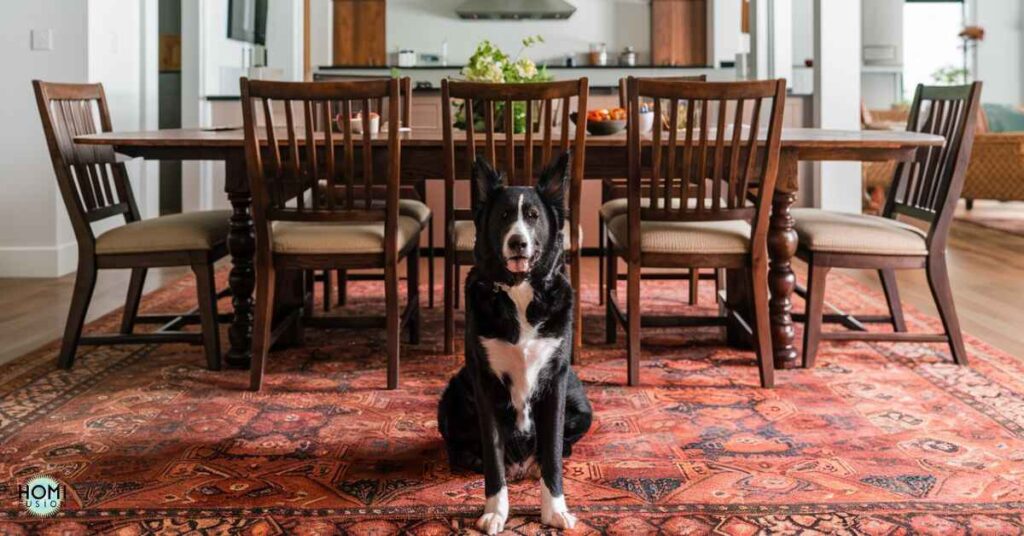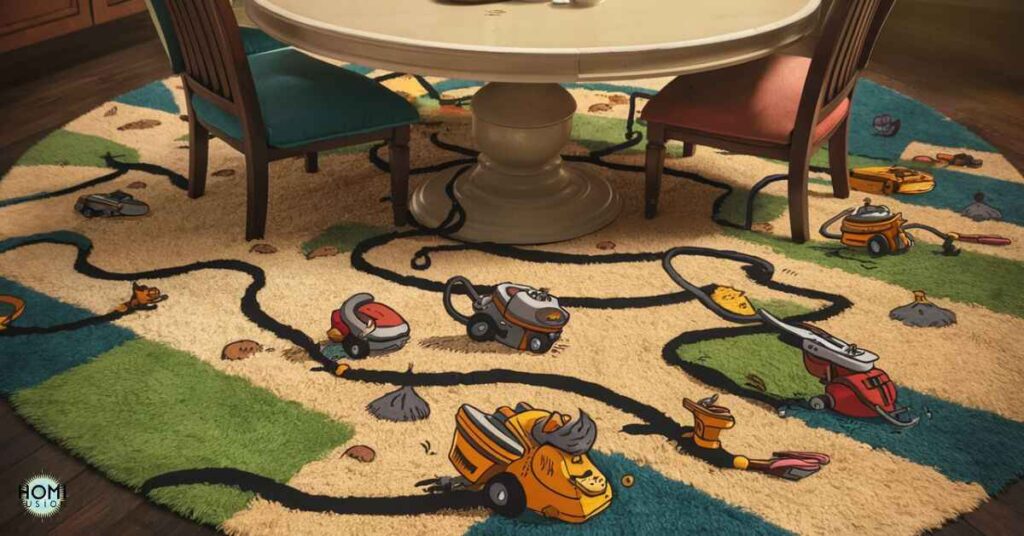Deciding whether to put a rug under your dining table is one of those controversial decorating questions that sparks endless debates. There’s no one-size-fits-all answer, but here’s the deal: the right rug can utterly transform a dining room’s entire look and vibe.
It adds instant ambiance, comfort, and style when chosen well. But get it wrong, and a rug can create all sorts of hassles and headaches. So what’s the verdict – should you take the plunge? This post dives deep into the pros and cons, offering expert tips to help you make the ideal choice for your space.
Get ready to explore gorgeous rug styling inspo and real-life anecdotes. By the end, you’ll be an informed rug-under-dining-table sage!
5 Awesome Reasons to Roll Out a Rug Under Your Dining Set
There are some seriously compelling upsides to anchoring your dining area with a well-picked rug. Here are five big ones interior designers rave about:
Insta-Ambiance: How a Well-Chosen Rug Elevates Any Dining Room
A rug is like an ultra-glam accessory that ties a room together. It adds layers of visual interest through color, pattern, and texture. An otherwise drab dining space can feel luxuriously cozy and inviting with the right rug grounding the setup.
Sock Feet Approved: The Cushy Comfort Factor

Hardwood, tile, or laminate floors can feel cold and unwelcoming underfoot, especially in chillier months. A plush area rug adds serious snuggly softness, making mealtimes way comfier for your tootsies.
Shh…Do You Hear That Silence? Reducing Noise in Open Layouts
If your dining area flows into other living spaces, sound can easily reverberate and create an echo chamber effect. A rug’s soft, insulating fibers absorb noise, resulting in a more hushed, peaceful atmosphere.
Protecting Those Pricey Floors from Scratches and Spills
Dining chairs constantly scooting in and out can scratch up floors over time. Plus, let’s be real – food and drink spills are inevitable. A durable, low-pile rug shields your flooring from wear and stains.
The Ultimate Voice of Authority: What the Interior Design Pros Recommend
“With the table centered and chairs pushed beneath, I suggest leaving at least 18-24 inches from the chair legs to the rug’s edges. This prevents snagging.” (Kelly Kuehn, Interior Designer)
Top designers overwhelmingly endorse rugs under dining tables, as long as they’re properly sized and the material can withstand high traffic. Their expert stamp of approval is convincing.
4 Situations Where Putting a Rug Under the Table is a No-Go
As marvelous as dining rugs can be, they’re not an ideal choice for every single situation. Here are four circumstances when skipping the rug could be wise:
Foot Traffic Nightmares: When the Dining Room Flow Gets Cramped
If your dining area is cramped or heavily trafficked, a rug could obstruct natural pathways and make the space feel even more congested. Rug edges are also tripping hazards in tight quarters.
Spill City: If You’ve Got Messy Little Ones or Pets Running Amok
Let’s be real – kids and fur babies tend to be rug destruction machines. Constant spills and stains may mean cleaning hassles outweigh the benefits. Unless you opt for an easily washable outdoor rug, go bare floor.
Maintenance Woes: For Those Who Hate Endless Vacuuming

Rugs require regular vacuuming and periodic deep cleaning to stay fresh. If that sounds like torture to you, a rug-free zone may be lower maintenance bliss.
The “Less is More” Aesthetic: Preserving that Minimalist Vibe
Some interior design styles favor clean lines and open, airy vibes. In minimalist, modern, or Scandinavian spaces, a rug could feel fussy and visually heavy.
What Size Rug Should You Get for Your Dining Table? Get the Measurements Right!
- Rug should extend at least 24-30 inches beyond table edges on all sides
- Allow 18-24 inches from chair backs to rug’s edge when chairs are pushed in
- For expandable tables, measure with extensions fully opened
- Choose a size that doesn’t overcrowd or intrude on natural walking paths
- Round rugs pair nicely with circular or square tables; rectangular for rectangular tables
Best Rug Materials and Styles to Complement Your Dining Set

The right material and style ensures your dining rug looks fabulous and lasts:
Materials:
- Wool or wool blends are ideal – durable, stain-resistant, and easy to clean
- Low-pile weaves like flatweave or tight looped styles
- Natural fiber options like jute or sisal add texture (but require more maintenance)
Styles:
- Patterns can add major pizazz – geometrics, ikats, damasks, and tribals are on-trend
- Solids or tonals create a subtle, understated foundation
- Match your interior aesthetic – e.g. vintage Persian for traditional, graphicprint for modern
Read this blog
How Tall Is A Dining Room Table
Real Talk from Real People: Dining Room Rug Confessions
Not sure if a dining rug is right for you? Hear from fellow homeowners who’ve been there:
“We have a super rustic farmhouse table, so I wanted something cozy but still sorta refined under it. Went with an overdyed vintage-inspired rug and LOVE the pop of color it adds!” (Jamie M., Austin, TX)
“Honestly, our dining rug is more for looks than anything. With two kids and a dog, it gets trashed constantly. But it feels so ‘done’ and expensive in that space, so I just resign myself to constant cleaning to keep it fresh.”
(Mark T., Philadelphia, PA)
“We did a patterned natural fiber rug under our mid-century style dining table and it’s perfect. Hides all the crumbs and chaos, but still feels modern and cohesive.” – Alia E., Seattle, WA
Step-by-Step Guide: How to Pick the Perfect Rug for Your Dining Area
Ready to take the plunge? Here’s a simple checklist for scoring that ideal rug situation:

1) Size It Right: Ensure the correct rug dimensions for your table shape and size. Extend at minimum 24-30″ beyond table edges.
2) Measure the Area: Map out the dining zone, accounting for major walkways. Avoid rugs that overcrowd or obstruct natural paths.
3) Get the Material Down: Low-pile, stain-resistant weaves like wool or wool-blends are best bets for spill-prone dining.
4) Embrace Your Style: The rug should vibe with your overall design aesthetic – traditional, modern, boho, etc. Use it to reinforce or uplift your space’s unique personality.
5) Prep for Inevitable Messes: Accept some staining will happen and get the right supplies – rug pads, spot cleaner, etc. Outdoor rugs can be hosed off!
6) Splurge If You Can: While budget options exist, higher quality rugs better withstand the wear and tear of dining duty. It’s an investment piece!
With this advice, you’re prepped to create a beautifully grounding, functional foundation for your dining room!
Also read
How Many Seats At A 6 Foot Rectangular Table
Frequently asked questions
Is it a good idea to put a rug under a dining table?
It can enhance ambiance, comfort, and protect floors, but may not suit every space due to maintenance and aesthetic considerations.
What is the rule of thumb for a rug under a dining table?
Extend the rug at least 24-30 inches beyond table edges and leave 18-24 inches from chair backs to the rug’s edge when chairs are pushed in.
What kind of rug to put under a dining room table?
Opt for durable materials like wool or blends, low-pile weaves, or natural fibers such as jute or sisal for texture. Choose patterns or solids that complement your interior style for a cohesive look.
Should dining room and living room rugs match?
Matching rugs can create cohesion, but they don’t have to be identical. Consider coordinating colors, patterns, or textures for a harmonious flow between spaces while allowing each room to have its unique flair.
Why do people put rugs in dining room?
Rugs in dining rooms add ambiance, comfort underfoot, protect floors, reduce noise, and enhance the overall look and feel of the space.
Does your furniture have to sit on the rug?
Furniture doesn’t have to sit entirely on the rug, but it should at least partially overlap for cohesion. This creates a visually connected and well-integrated space.
Conclusion
In the grand debate over putting a rug under the dining table, there’s no definitive right or wrong answer. It comes down to your lifestyle, design aesthetic, and willingness to maintain it. A well-chosen rug can impart unbeatable coziness, sound absorption, and style.
But it requires strategic sizing, material selection, and potentially more cleaning effort. If you love plush textiles and have a lower traffic space, go for it! For minimalists or homes with messy kiddos, bare floors may be best.
Whichever route you choose, make an informed decision that enriches your dining experience and decor. With these insights, you’re empowered to make your dining room’s rug situation absolutely masterful.







